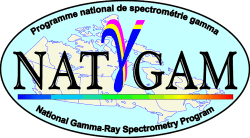| ||||||||||||||||||||||||||||
 Proactive disclosure Print version |  Radiation Geophysics NATGAM

Multisensor airborne surveys, combining gamma-ray spectrometry, magnetic and electromagnetic data, contribute fundamental geophysical and geochemical information to the national geoscience knowledge framework. For over 60 years, the Geological Survey of Canada has been a world leader in developing equipment and methods for accurately measuring natural radioactivity. This tradition of innovation runs from the evolution of airborne and portable field spectrometers in the 1960s to creating international calibration standards in the 1990s. Systematic airborne radioactivity mapping of Canada began in 1969, using the GSC's Skyvan aircraft. In the late 1970s, additional coverage was obtained using commercial contractors, funded by the cooperative, federal-provincial Uranium Reconnaissance Program (URP), laying the groundwork for a partnership approach that has become the hallmark of today's NATGAM program. In the 1980's and early 1990's, increasing recognition of important mapping and exploration applications of gamma-ray spectrometry prompted a succession of surveys, funded under several federal-provincial Mineral Development Agreements throughout Canada. Current NATGAM airborne gamma-ray spectrometry survey coverage. In 1998, the GSC established the new National Gamma-Ray Spectrometry Program
(NATGAM) that promotes a partnership approach to collecting and
sharing of high quality gamma-ray spectrometry data throughout Canada and
effective application of this information to a broad range of
geoscientific activities.
Recent government partnership initiatives, such as the GSC's EXTECH and NATMAP programs, as well as multidisciplinary projects with the governments of Yukon, British Columbia and New Brunswick, have combined gamma-ray spectrometry with other geophysical methods to provide rewarding new views of established and frontier regions. NATGAM's well-established, partnership approach recognizes that a responsibility for meeting Canada's geoscientific knowledge requirements is shared with provincial, university and industrial partners. NATGAM is intended to foster ongoing collection of high quality public domain gamma-ray spectrometry data throughout Canada, through joint public and private sector funding, and to promote effective application of these data to a broad range of geoscientific activities. The GSC's internationally recognized leadership in gamma-ray spectrometry surveying is based on practical applications that have resulted in many Canadian exploration success stories in a wide range of geological settings. These demonstrate the unique ability of gamma-ray spectrometry to meet the requirements of traditional geoscientific activities such as surficial and bedrock geological mapping and mineral exploration, as well as the growing need for environmental knowledge. Through innovative partnerships, NATGAM will meet these demands
and offer significant benefits to all participants and stakeholders.
Industry partners provide funding in exchange for reduced
survey costs, quality control, exclusivity, contract supervision,
data interpretation and follow-up assistance. Governments
contribute funding and expertise, with the goal of collecting
publicly accessible data, to national standards, at reduced
cost. Various stakeholders (non-participating
exploration industry, bedrock and surficial geological mappers,
prospectors, environmentalists, land use planners) ultimately
gain timely access to high quality geophysical/geochemical data.
Case history - Yukon Territory
We welcome enquiries about survey joint ventures or any aspect of
gamma-ray spectrometric/magnetic/VLF-EM surveys. For more information,
please contact us.
| |||||||||||||||||||||||||||||||||||||||||||||||||||||||||||||||||